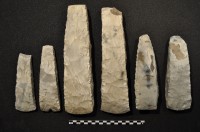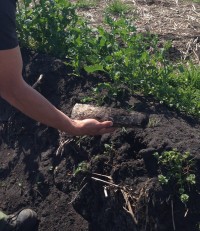 It was the recent discovery of the sixth axe that set the wheels in motion for its reunion with its five brethren, but the story begins in 1930 when a farmer discovered a Neolithic flint axe in a field near Snostrup on the Roskilde Fjord in southwestern Denmark. The axe was 27 centimeters (10.6 inches) long and roughly hewn. Over time the farmer found another four axes with the same coarse finish. In 1975, National Museum of Denmark curator CL Vedbæk visited the farmer and documented the axes. Treasure trove laws were different then; after the artifacts were recorded, they stayed with the finder.
It was the recent discovery of the sixth axe that set the wheels in motion for its reunion with its five brethren, but the story begins in 1930 when a farmer discovered a Neolithic flint axe in a field near Snostrup on the Roskilde Fjord in southwestern Denmark. The axe was 27 centimeters (10.6 inches) long and roughly hewn. Over time the farmer found another four axes with the same coarse finish. In 1975, National Museum of Denmark curator CL Vedbæk visited the farmer and documented the axes. Treasure trove laws were different then; after the artifacts were recorded, they stayed with the finder.
Forty-one years later, an archaeological excavation in the same field unearthed another rough axe. Museum Group ROMU archaeologist Jens Winther Johannsen was part of the excavation team. He remembered there were other Neolithic axes found in the field and decided to seek out the family. He asked around and was able to locate one of the farmer’s sons. As luck would have it, the family had kept the axes together and in good condition and the son wanted to hand them in to the National Museum. The National Museum judged them to be treasure trove. The state gets to keep the axes and the farmer’s family will get a finder’s fee.
The five previously excavated axes were transferred to the Museum Group ROMU, thus reuniting them with the sixth one unearthed this year. Examination of the group found that all of the axes are so roughly worked they are classified as intermediate goods, begun, but not completed. They would have had to be reworked, sharpened and polished on a grinding wheel before they could be used. National Museum curator Peter Vang Petersen and Jens Winther Johannsen think that the six axes were deposited together and then spread all over the field by subsequent cultivation. The whitish color of the axes indicates they spent many centuries in the same place where the soil conditions affected their color. They are made out of the same type of flint, and stylistically they all date to the mid-Neolithic, about 2,800-2,600 B.C.
 The field where they were discovered was a marsh during the Neolithic. The area wasn’t drained and developed for agriculture until the 19th century. As a general interpretative rule, archaeologists believe deposits in wetlands were religious offerings, sacrifices, ritual “killings” of powerful objects, while objects buried in dry soil were stored for later retrieval. The six axes, therefore, are thought to have been ritually sacrificed to the gods by deposition in the marsh.
The field where they were discovered was a marsh during the Neolithic. The area wasn’t drained and developed for agriculture until the 19th century. As a general interpretative rule, archaeologists believe deposits in wetlands were religious offerings, sacrifices, ritual “killings” of powerful objects, while objects buried in dry soil were stored for later retrieval. The six axes, therefore, are thought to have been ritually sacrificed to the gods by deposition in the marsh.
As for why unfinished flint axes might have been considered desirable sacrifices, archaeologists have found both finished and intermediate flint objects deposited in wetlands. Petersen hypothesizes that the form may not have been the important factor, rather the material used. The sacrifice of flint objects may have been a kind of tax or toll due to the gods for all the flint removed from the earth. Neolithic Danes were well aware of the value and importance of flint. Eastern Denmark was the center of flint production in northern Europe. From there, they were exported east to the island of Bornholm in the Baltic Sea and north to Sweden and Norway where there is no natural source of flint.
There are no current plans to display all six of the flint axes. The five that were found by the farmer will probably be part of the National Museum’s exhibition of select artifacts that were declared treasure trove the year before. That won’t happen until 2017.
I’m sorry to make a correction. Roskilde is a town in the east of Denmark – near Copenhagen.
Axes were offered -or ‘deposited’- also later in the beginning Bronze Age.
To give an example from Germany: “100 axes of different shape and manufacturing quality were laid down about 3,800 years ago in a clay pot”.
Maybe this counts as an example for tax evasion: You could have unearthed the pot with all those axes anytime, in order to trade them in. With a pot of axes buried next to your home this is, of course, much easier than with stone axes buried in far off offshore wetlands.